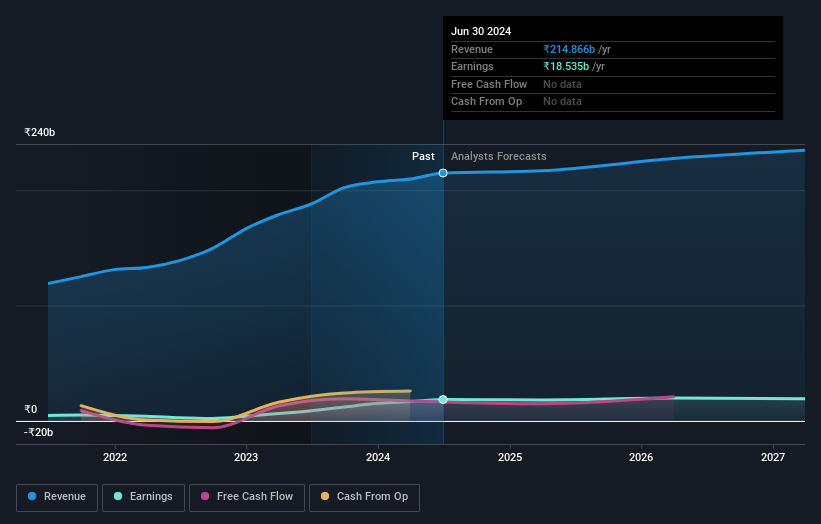- India
- /
- Metals and Mining
- /
- NSEI:JINDALSAW
Jindal Saw Limited Just Beat Earnings Expectations: Here's What Analysts Think Will Happen Next
It's been a pretty great week for Jindal Saw Limited (NSE:JINDALSAW) shareholders, with its shares surging 16% to ₹647 in the week since its latest first-quarter results. Revenues missed the mark, coming in 10% below forecasts, at ₹49b. Statutory profits were better overall though, with per-share profits of ₹13.80 being a notable 19% above what the analysts were modelling. Following the result, the analysts have updated their earnings model, and it would be good to know whether they think there's been a strong change in the company's prospects, or if it's business as usual. With this in mind, we've gathered the latest statutory forecasts to see what the analysts are expecting for next year.
See our latest analysis for Jindal Saw

Taking into account the latest results, Jindal Saw's dual analysts currently expect revenues in 2025 to be ₹216.8b, approximately in line with the last 12 months. Statutory earnings per share are forecast to dip 2.1% to ₹57.05 in the same period. Yet prior to the latest earnings, the analysts had been anticipated revenues of ₹232.6b and earnings per share (EPS) of ₹55.65 in 2025. If anything, the analysts look to have become slightly more optimistic overall; while they decreased their revenue forecasts, EPS predictions increased and ultimately earnings are more important.
There's been a 8.6% lift in the price target to ₹871, with the analysts signalling that the higher earnings forecasts are more relevant to the business than the weaker revenue estimates.
One way to get more context on these forecasts is to look at how they compare to both past performance, and how other companies in the same industry are performing. It's pretty clear that there is an expectation that Jindal Saw's revenue growth will slow down substantially, with revenues to the end of 2025 expected to display 1.2% growth on an annualised basis. This is compared to a historical growth rate of 16% over the past five years. By way of comparison, the other companies in this industry with analyst coverage are forecast to grow their revenue at 11% per year. Factoring in the forecast slowdown in growth, it seems obvious that Jindal Saw is also expected to grow slower than other industry participants.
The Bottom Line
The most important thing here is that the analysts upgraded their earnings per share estimates, suggesting that there has been a clear increase in optimism towards Jindal Saw following these results. Unfortunately, they also downgraded their revenue estimates, and our data indicates underperformance compared to the wider industry. Even so, earnings per share are more important to the intrinsic value of the business. Even so, earnings are more important to the intrinsic value of the business. We note an upgrade to the price target, suggesting that the analysts believes the intrinsic value of the business is likely to improve over time.
With that in mind, we wouldn't be too quick to come to a conclusion on Jindal Saw. Long-term earnings power is much more important than next year's profits. At least one analyst has provided forecasts out to 2027, which can be seen for free on our platform here.
Don't forget that there may still be risks. For instance, we've identified 2 warning signs for Jindal Saw that you should be aware of.
New: Manage All Your Stock Portfolios in One Place
We've created the ultimate portfolio companion for stock investors, and it's free.
• Connect an unlimited number of Portfolios and see your total in one currency
• Be alerted to new Warning Signs or Risks via email or mobile
• Track the Fair Value of your stocks
Have feedback on this article? Concerned about the content? Get in touch with us directly. Alternatively, email editorial-team (at) simplywallst.com.
This article by Simply Wall St is general in nature. We provide commentary based on historical data and analyst forecasts only using an unbiased methodology and our articles are not intended to be financial advice. It does not constitute a recommendation to buy or sell any stock, and does not take account of your objectives, or your financial situation. We aim to bring you long-term focused analysis driven by fundamental data. Note that our analysis may not factor in the latest price-sensitive company announcements or qualitative material. Simply Wall St has no position in any stocks mentioned.
Have feedback on this article? Concerned about the content? Get in touch with us directly. Alternatively, email editorial-team@simplywallst.com
About NSEI:JINDALSAW
Jindal Saw
Engages in the manufacture and supply of iron and steel pipes, and pellets in India and internationally.
Adequate balance sheet average dividend payer.
Similar Companies
Market Insights
Community Narratives


Recently Updated Narratives


Alphabet: The Under-appreciated Compounder Hiding in Plain Sight


MINISO's fair value is projected at 26.69 with an anticipated PE ratio shift of 20x


The Quiet Giant That Became AI’s Power Grid
Popular Narratives


The company that turned a verb into a global necessity and basically runs the modern internet, digital ads, smartphones, maps, and AI.


MicroVision will explode future revenue by 380.37% with a vision towards success



